
Situation of Diabrotica virgifera virgifera in the EPPO region (2012)
Introduction of Diabrotica virgifera virgifera into Europe
The Western Corn Rootworm, Diabrotica virgifera virgifera (Coleoptera: Chrysomelidae), was introduced in the 1990s into Serbia. This is an important pest of maize occurring in North America, whose soil-inhabiting larvae can seriously damage roots of maize (Zea mays) and lead to yield losses. D. virgifera virgifera was first detected in July 1992 in the locality of Surcin near the Belgrade International Airport. The origin of this introduction remains unknown. Once introduced into Europe, D. virgifera virgifera started to spread at a rather rapid pace in Danube basin. In addition, several foci outside Danube basin are now reported. Preliminary studies on the potential of establishment of D. virgifera virgifera carried out by researchers in Croatia, France, Germany and by FAO for the whole of Europe have showed that this pest is likely to survive and develop wherever maize is grown in Europe.
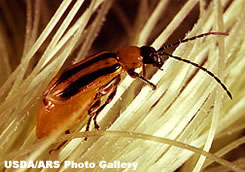
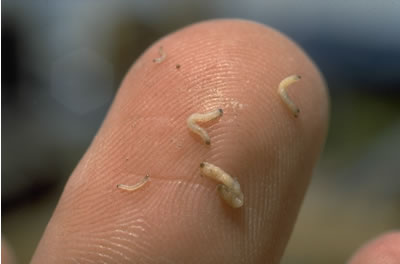
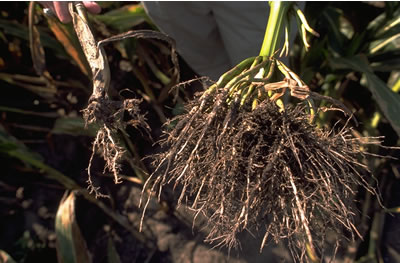
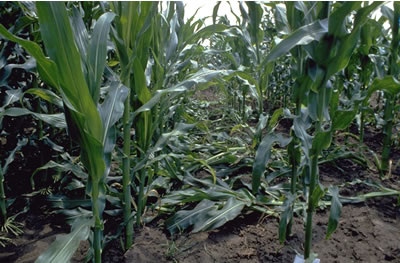
Situation of Diabrotica virgifera virgifera in Europe (2012)
Since its introduction, D. virgifera virgifera has been spreading in Europe. Looking at a physical map of this region, it seems that D. virgifera virgifera has almost filled up what could be called the great Hungarian plain. Since a few years now, it has also been caught outside this region. In 1998, it was trapped near Venezia airport (Marco Polo) in Italy, in this region of Italy an eradication programme is being carried out. Again in 2000, D. virgifera virgifera was caught in 2 new airports of Italy and Switzerland: in Milano (Malpensa) and Lugano/Agno. In 2001, it appeared that these two 'spot introductions' were in fact parts of an outbreak covering a rather large area in Ticino, Lombardia and Piemonte. Eradication is not envisaged in this area. A new outbreak was detected in 2002 near Aviano military airport in Friuli-Venezia-Giulia. In 2002, D. virgifera virgifera was also found for the first time in France near Roissy, Le Bourget and Orly airports (near Paris) and eradication measures are being taken. In 2003, new outbreaks were reported in France (in Alsace), in Belgium, in the Netherlands, and in United Kingdom, again near international airports. As a consequence of these new findings, the Commission of the European Union has issued emergency measures (Commission Decision 2003/733/EC of 24 October 2003 on emergency measures to prevent the spread within the Community of Diabrotica virgifera LeConte). In 2004, the pest continued to spread in most areas where it was present. No new country was reported to be infested in 2004. In addition, in several areas where eradication and containment measures are being applied, D. virgifera virgifera was no longer found in 2004 (i.e: Alsace (in France), Netherlands, Swiss region at the north of the Alps). In areas near Paris airports (FR), Heathrow (UK), Zaventem (BE), Venezia (IT) and in Ticino (CH), only low numbers of beetles were caught. In 2005, D. virgifera virgifera was caught for the first time in Poland, and few specimens were trapped again in the Netherlands near Schipol airport. In 2007, D. virgifera virgifera was detected for the first time in Germany (Baden-Württemberg and Bayern) and eradication measures were taken. In 2009, D. virgifera virgifera was caught for the first time in Belarus, near the borders with Poland and Ukraine; as well as in the north of Greece (prefectures of Thessaloniki, Serres, Florina and Pieria). In 2010/2011, no captures were made in Belgium, Netherlands and the UK. In August 2001, the first specimens were caught in Russia (near Matveev Kurgan, in the Rostov region). The map below presents the situation of D. virgifera virgifera in Europe in 2011 as a result of surveys carried out by the NPPOs. It must be stressed that economic damage has only been seen on maize in Serbia, and in some bordering areas in Croatia, Hungary, Romania, and small areas in Bosnia-Herzegovina and Bulgaria.
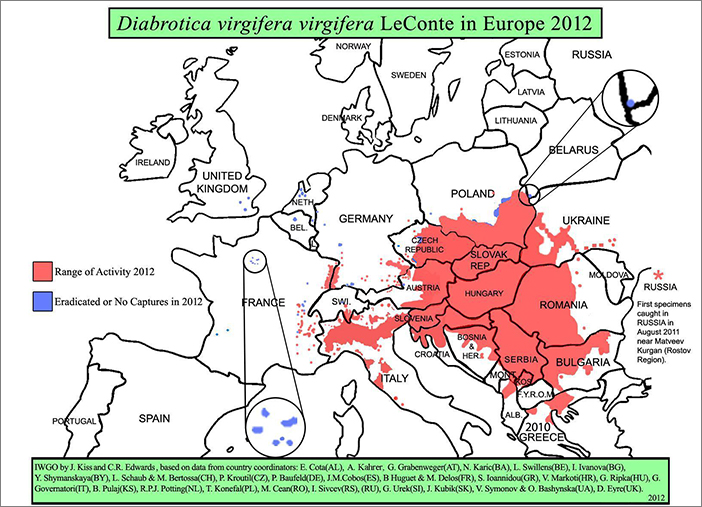
First reports of D. virgifera virgifera in individual countries
Details on the first reports of D. virgifera virgifera in European countries have been published in the EPPO Reporting Service or in reports of IWGO/EPPO meetings. Extracts from these documents can be viewed here for each country.
Note: since 2012, the situation of D. virgifera virgifera in the countries listed above may have changed.
Current distribution can be consulted in the EPPO Global Database ![]()
International cooperation against Diabrotica virgifera virgifera
In view of the difficulties in preventing the spread of D. virgifera virgifera, the initiative was taken by IWGO (the International working Group on Ostrinia and other maize pests of IOBC) to organize international cooperation. A first international meeting was held in Graz, Austria (1995-03-20/21) and it was decided to establish a monitoring programme in countries at risk and to work on possible control methods. Since that time, IWGO has organized every year an international Conference in order to present the results of the monitoring programme carried out in Central and Eastern Europe. At the beginning curcurbitacins traps were used, but pheromone traps were rapidly developed by Hungarian researchers and were found particularly suitable for the early detection of the pest populations. Yellow sticky traps are also used but were found more suitable when population have reached a certain level. During these Conferences, results of research activities on the trapping and control of D. virgifera virgifera conducted in Europe and also in USA are presented.
In 1996, a joint EPPO/IWGO ad hoc Panel was created to facilitate participation of as many European countries as possible in international activities and to promote information exchange. D. virgifera virgifera was listed by the EPPO Council as an A2 quarantine pest in 1994, and Specific Phytosanitary Requirements (PSPRs) were agreed in September 1998. These SQRs provide restrictions on the movement of soil, fresh plants or parts of plants from infested areas to try to limit spread, at least over long distances, as it must be acknowledged that the insect can readily spread over shorter distances by natural flight. However, it must be stressed here that D. virgifera virgifera is not transmitted by maize grains or seeds, as the insect does not feed on grain seeds and is not likely to be found on them at the time of harvest.
In 1997, an FAO/TCP group was created to coordinate trapping activities both for monitoring and containment purposes. Dissemination of information leaflets was also promoted by this group for countries at risk in Central and Eastern Europe. This project ended in February 1999. As all participating countries stressed the need to continue such international cooperation, an FAO project was undertaken. It still considered containement, control and monitoring but also included research on biology, population dynamics, economic thresholds and management.
In the 2000s, several EU research projects were initiated on this pest. For example:
- "The threat to maize production in the EU by the exotic corn rootworm pest Diabrotica virgifera virgifera: sustainable pest management approaches and ecological background". Its aim was to provide advice to the EU on how to continue research and organize action against D. virgifera virgifera. It focused on the biology, host plants, IPM, trapping methods.
- "Harmonise the strategies for fighting Diabrotica virgifera virgifera". Its aims were to increase awareness and understanding of the problems caused by D. virgifera virgifera virgifera encountered by plants breeders, farmers, and plant protection services; to harmonise and improve control and prevention of pest populations in Europe; and to identify the priority research areas and minimising parallel research.
Reports of International Meetings
- 1st International Meeting on Diabrotica virgifera virgifera LeConte, 1995-03-20/21, Graz, Austria
- 2nd International Meeting on Diabrotica virgifera virgifera LeConte, 1995-11-08, Gödöllö, Hungary
- 3rd International IWGO Workshop and 1st EPPO ad hoc Panel on Diabrotica virgifera virgifera LeConte, 1996-10-16/17, Zagreb, Croatia
- 4th International IWGO Workshop, 2nd EPPO ad hoc Panel and 2nd FAO/TCP Meeting on Diabrotica virgifera virgifera LeConte, 1997-10-29/30, Gödöllö, Hungary
- 5th International IWGO Workshop, 3rd EPPO ad hoc Panel and 3rd FAO/TCP Meeting on Diabrotica virgifera virgifera LeConte, 1998-10-28/29, Rogaska Slatina, Slovenia
- 6th International IWGO Workshop, 4th EPPO ad hoc Panel Meeting on Diabrotica virgifera virgifera LeConte, 1999-11-04/05, Paris, France
- 7th International IWGO Workshop, 5th EPPO ad hoc Panel Meeting on Diabrotica virgifera virgifera LeConte, 2000-11-16/17, Stuttgart, Germany
- 8th International IWGO Workshop, 6th EPPO ad hoc Panel Meeting on Diabrotica virgifera virgifera LeConte, 2001-10-28/29, Venezia, Italy
- 9th International IWGO Workshop, 7th EPPO ad hoc Panel Meeting on Diabrotica virgifera virgifera LeConte, 2002-11-03/05, Belgrade
- 10th International IWGO Workshop, 8th EPPO ad hoc Panel Meeting on Diabrotica virgifera virgifera LeConte, 2004-01-14/16, Engelberg, Switzerland
Assessment of larval damage: Iowa scale
Assessment of the amount of damage by larval feeding of D. virgifera virgifera on maize roots can be done by digging out the root system taking a diameter of approximately 25 cm to a depth of 15 cm. As much soil as possible is removed from the roots by gentle shaking and/or beating, care being taken not to break off any of the crown roots. The root systems are then washed so that all crown roots are fairly clean.
Damage on the root systems can be assessed by using a scale such as the following (Iowa State University 1 to 6 scale)
1 = No visible damage or only few minor feeding scars (not illustrated, but similar to a rating of two);
2 = Visible feeding scars present but no roots eaten off to within 4 cm of the plant, or with one or two shortened roots if the rest of the system was relatively free of damage;
3 = Several roots eaten off to within 4 cm of the plant, but never the equivalent of an entire node of roots destroyed
4 = One node of roots destroyed or the equivalent completely destroyed
5 = Two nodes of roots destroyed completely
6 = Three or more nodes completely destroyed (not illustrated, but similar to a rating of five)
('destroyed' means 'of no functional value to the plant')
These drawings show damage at approximately 67 days after planting. They represent the appearance of a given root system for each of 4 damage categories (2-5). Root-bearing nodes are numbered from one to seven, with roots of node eight just beginning to appear. The darkened areas represent significant damage from feeding and tunneling.
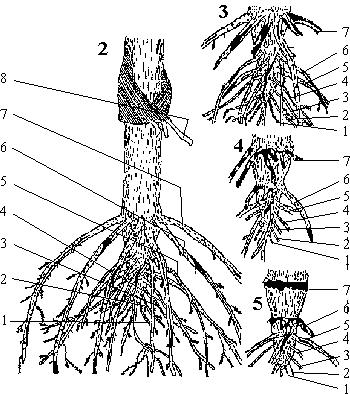
('destroyed' means 'of no functional value to the plant')
These drawings show damage at approximately 67 days after planting. They represent the appearance of a given root system for each of 4 damage categories (2-5). Root-bearing nodes are numbered from one to seven, with roots of node eight just beginning to appear. The darkened areas represent significant damage from feeding and tunneling.
Another Iowa scale (1 to 3) can also be used and be downloaded from: http://www.ent.iastate.edu/pest/rootworm/nodeinjury/nodeinjuryl
Useful links
- IWGO (International Working Group on Ostrinia and other maize pests)
- Purdue University (US) - Distribution maps of D. virgifera virgifera in North America and Europe (2004 to 2012)
